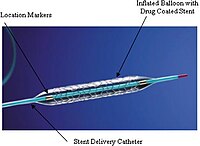
Photo from wikipedia
Background Due to the steadily increasing life expectancy of the population, the need for medical aids to maintain the previous quality of life is growing. The basis for independent mobility… Click to show full abstract
Background Due to the steadily increasing life expectancy of the population, the need for medical aids to maintain the previous quality of life is growing. The basis for independent mobility is a functional locomotor system. The hip joint can be so badly damaged by everyday wear or accelerated by illness that reconstruction by means of endoprostheses is necessary. Results In order to ensure a high quality of life for the patient after this procedure as well as a long service life of the prosthesis, a high-quality design is required, so that many different aspects have to be taken into account when developing prostheses. Long-term medical studies show that the service life and operational safety of a hip prosthesis by best possible adaptation of the stiffness to that of the bone can be increased. The use of additive manufacturing processes enables to specifically change the stiffness of implant structures. Conclusions Reduced implant stiffness leads to an increase in stress in the surrounding bone and thus to a reduction in bone resorption. Numerical methods are used to demonstrate this fact in the hip implant developed. The safety of use is nevertheless ensured by evaluating and taking into account the stresses that occur for critical load cases. These results are a promising basis to enable longer service life of prostheses in the future.
Journal Title: BioMedical Engineering OnLine
Year Published: 2022
Link to full text (if available)
Share on Social Media: Sign Up to like & get
recommendations!